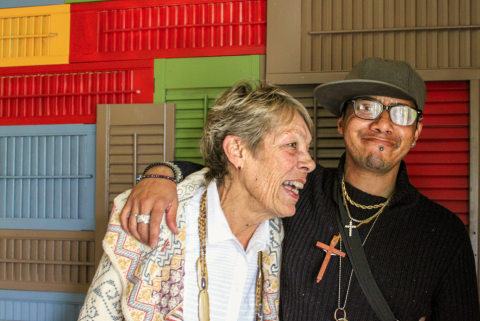‘Village’ of Larimer County providers support woman’s journey to recovery, housing stability
Self-determination, support of Longview, Garcia House teams key to Crystal Stearns’ progress
James “Crystal” Stearns was abandoned as a baby in a dumpster and later sold for sex. She got out on her own, but freedom meant living on Denver’s streets as a 7-year-old child.
From homelessness to psychosis to drug abuse, the 45-year-old has survived a torrent of trauma. “I was raised in drama. I wasn’t raised right,” she says.
Today, she is in recovery from substance-use disorder and living in a supportive facility in Loveland. Notably, it took the will of a community – as much as that of the self-described “loner” – to get there.
Bejeweled costume bracelets, three watches, and strands of beads criss-cross Stearns’ arms, and the multiple crosses hanging from her neck make her feel protected.
Another source of protection for Stearns sat mere inches away, in a small wooden chair at a small wooden table in the entrance of Primrose Place Assisted Living.
Ruth Carrothers isn’t just a case manager with SummitStone Health Partner’s clinical team. She is the person who rallied a team of providers to persevere through Stearns’ care, the person who didn’t give up on her, despite multiple attempts at sobriety, and her best friend.
“She’s like my mother,” Stearns says, fondly and often, of Carrothers. Like families do, they trade smiles, laughs and moments of exasperation, while telling the story of their intersecting life paths.
“She still texts me 10 times a day,” Carrothers says, to which Stearns responds, cheekily, “‘Til the day I die.”
“It’s because you’re worth it,” Carrothers says, looking at Stearns with stress-worn but proud eyes.
The two met around 2021 when Stearns started seeking care at SummitStone Health Partner’s former behavioral health crisis center in Fort Collins. Shirtless and walking in torn shoes, Stearns was a common sight along Riverside Avenue, suffering from the effects of drug use, psychosis, and a life-threatening health condition.
She made dozens of visits to the former crisis center on Riverside (and later to Longview), as physical and behavioral health continued to elude her. Staff members, like Madi Montes, would invite her in for a meal and give her clothes. Those acts of kindness started to turn the tides of trust.
“I didn’t believe that people really gave a ****. That people really cared,” Stearns said.
Montes is a SummitStone clinical program supervisor, and licensed addictions counselor and licensed clinical social worker. Back then, she saw Stearns was hurting, lost and afraid – insecure about herself and her place in society.
She started her journey to recovery like so many others, believing that she didn’t have a problem. Throwing things and cussing. Struggling with anger management. It wasn’t always easy for her care team to persist.
When spots on the waitlist opened, Stearns gave the treatment program at SummitStone’s Garcia House a try, and then another, without initial success.

Breaking the cycle of addiction isn’t as simple as “just stopping.” Substance-use disorder is a treatable disease, but it can be a difficult road – particularly for people like Stearns, who have a dual diagnosis of mental health and substance-use disorders. It can take time and a variety of approaches.
By this point, the Riverside crisis center was closed, and Stearns started finding rides to the Acute Care facility at Longview campus between admissions to Garcia House.
Made possible by a 20-year behavioral health tax initiative and located between Loveland and Fort Collins, the center is open 24/7/365 for people of all ages. It brings behavioral health crisis care, medically managed withdrawal (or detox), and more under one roof, and is licensed to provide a higher level of care than existed previously in our community. Larimer County holds a contract with SummitStone to provide services.
“Longview was like a Godsend,” said Carrothers, a “social justice activist” who has worked at the local and state levels to advance behavioral health care and rights for victims of sex assault. “It is the best thing that’s ever happened to Larimer County.”
The consistency, compassion and quality of care Stearns experienced at Longview, combined with care from Carrothers and others, finally did the trick.
Working at a community crisis center like Acute Care at Longview campus means meeting people where they’re at, Montes said. It requires intentionality and recognition that clients’ challenges and negative behaviors are symptoms, not indicators of who they are.
“That’s just kind of a beautiful thing that we get to do here at Longview. It’s just viewing that person as a community member and that supporting them is supporting our community,” she said.
Sometimes, Stearns said, they were the only people who saw her as human.
“There were times they (the Garcia House team) could’ve kicked me out, but they didn’t,” says Stearns, who struggled with anger and adjusting to the significant change of living indoors after being unhoused for decades.
“They saw potential in me to do something. It took a couple of admissions to turn that corner. I saw that corner. I wanted to be there.”
“It’s been really cool to come alongside her in her journey and help her find herself – and grow into a confident and just hilarious person,” Montes said. “It’s amazing what patience and perseverance can do.”
Displayed on the wall of her tiny but brightly decorated bedroom in Primrose Place, are two certificates that recognize her “graduation” from Garcia House and completion of intensive outpatient treatment. In total, she spent 166 days there in 2024.

Graduating meant she was ready to move to Primrose, where she lives with 17 other people. As of April 2025, she continues treatment and is building skills so she can move out.
“I know I’m going to be here for a few,” says Stearns. “Then I want to get a job. A little apartment.”
In the meantime, she continues to show self-determination, resourcefulness and resilience that should be celebrated, Carrothers says. “It’s unbelievable. Everybody’s worked hard – Crystal and everyone.”
Stearns chose to share her story in the hope that it helps others.
“You can change. You can work your way through your drama,” says the woman who admits she isn't yet confident in herself but is confident in that statement.
“There’s always hope,” Carrothers adds. “Hope is free, right?”
Even when things can seem grim across the behavioral health landscape – particularly with recent cuts in federal and state funding – hope is worth holding onto. And for Carrothers, people like Crystal embody the hope that keeps her going.

Madeline Novey
Communication Specialist
Behavioral Health Services
970-619-4255
noveyme@co.larimer.co.us
